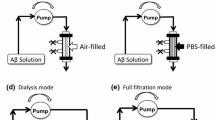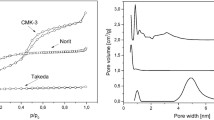Abstract
Amyloid beta proteins (Aβ) in the brain are the main cause of Alzheimer’s disease. Peripheral administration of Aβ-binding substances, which may act as a sink for Aβ from the brain, has been reported to reduce brain Aβ. We previously found C16-cellulose beads had high Aβ-removal activity in vitro. In this study, we investigated the optimum surface properties of adsorbents for removal of Aβ in vitro and in humans. Batch analysis was performed with porous cellulose beads or silica beads with or without 2–22 methylene groups. Aβ-removal activity of C16-cellulose beads increased with increasing alkyl chain length. In contrast, with cellulose the amount of Aβ removed by the silica beads decreased with increasing alkyl chain length. Cellulose beads with 16 or 22 methylene groups were best (over 99 % removal) among all the beads tested (p ≤ 0.01). The adsorbent surfaces were analyzed by near-infrared spectroscopy, which revealed that the optimum beads had a sufficiently hydrophobic surface with an appropriate amount of adsorbed water accessible on the surface. Aβ removal efficiency by C16-cellulose beads was investigated for 5 renal failure patients on hemodialysis, resulting in 51.1 ± 6.6 % for Aβ1–40 and 43.8 ± 4.5 % for Aβ1–42 (p ≤ 0.01). In conclusion, cellulose beads with 16 or 22 methylene groups and an appropriate amount of adsorbed water were the optimum Aβ adsorbents. The device with C16-cellulose beads had high Aβ removal activity in humans. These adsorbents might be useful for Alzheimer’s disease therapy.






Similar content being viewed by others
References
Selkoe DJ. Alzheimer’s disease: genes, proteins, and therapy. Physiol Rev. 2001;81:741–66.
Hung LW, Ciccotosto GD, Giannakis E, Tew DJ, Perez K, Masters CL, Cappai R, Wade JD, Barnham KJ. Amyloid-β peptide (Aβ) neurotoxicity is modulated by the rate of peptide aggregation: Aβ dimers and trimers correlate with neurotoxicity. J Neurosci. 2008;28:11950–8.
Walsh DM, Klyubin I, Fadeeva JV, Cullen WK, Anwyl R, Wolfe MS, Rowan MJ, Selkoe DJ. Naturally secreted oligomers of amyloid b protein potently inhibit hippocampal long-term potentiation in vivo. Nature. 2002;416:535–9.
Hock C, Konietzko U, Streffer JR, Tracy J, Signorell A, Müller-Tillmanns B, Lemke U, Henke K, Moritz E, Garcia E, Wollmer MA, Umbricht D, de Quervain DJ, Hofmann M, Maddalena A, Papassotiropoulos A, Nitsch RM. Antibodies against beta-amyloid slow cognitive decline in Alzheimer’s disease. Neuron. 2003;38:547–54.
Matsuoka Y, Saito M, LaFrancois J, Saito M, Gaynor K, Olm V, Wang L, Casey E, Lu Y, Shiratori C, Lemere C, Duff K. Novel therapeutic approach for the treatment of Alzheimer’s disease by peripheral administration of agents with an affinity to β-amyloid. J Neurosci. 2003;23:29–33.
Liu Y, Studzinski C, Beckett T, Guan H, Murphy MP, Klein R, Hersh LB. Expression of neprilysin in skeletal muscle reduces amyloid burden in a transgenic mouse model of Alzheimer disease. Mol Ther. 2009;17:1381–6.
Boada M, Ortiz P, Anaya F, Hernández I, Muñoz J, Núñez L, Olazarán J, Roca I, Cuberas G, Tárraga L, Buendia M, Pla RP, Ferrer I, Páez A. Amyloid-targeted therapeutics in Alzheimer’s disease: use of human albumin in plasma exchange as a novel approach for Abeta mobilization. Drug News Perspect. 2009;22:325–39.
Mawuenyega KG, Sigurdson W, Ovod V, Munsell L, Kasten T, Morris JC, Yarasheski KE, Bateman RJ. Decreased clearance of CNS beta-amyloid in Alzheimer’s disease. Science. 2010;330:1774.
Geylis V, Steinitz M. Immunotherapy of Alzheimer’s disease (AD): from murine models to anti-amyloid beta (Aβ) human monoclonal antibodies. Autoimmun Rev. 2006;5:33–9.
Bayer AJ, Bullock R, Jones RW, Wilkinson D, Paterson KR, Jenkins L, Millais SB, Donoghue S. Evaluation of the safety and immunogenicity of synthetic Aβ42 (AN1792) in patients with AD. Neurology. 2005;64:94–101.
DeMattos RB, Bales KR, Cummins DJ, Paul SM, Holtzman DM. Brain to plasma amyloid-b efflux: a measure of brain amyloid burden in a mouse model of Alzheimer’s disease. Science. 2002;295:2264–7.
Donahue JE, Flaherty SL, Johanson CE, Duncan JA, Silverberg GD, Miller MC, et al. RAGE, LRP-1, and amyloid-beta protein in Alzheimer’s disease. Acta Neuropathol. 2006;112:405–15.
Bell RD, Sagare AP, Friedman AE, Bedi GS, Holtzman DM, Deane R, et al. Transport pathways for clearance of human Alzheimer’s amyloid beta-peptide and apolipoproteins E and J in the mouse central nervous system. J Cereb Blood Flow Metab. 2007;27:909–18.
Kawaguchi K, Kitaguchi N, Nakai S, Murakami K, Asakura K, Mutoh T, Fujita Y, Sugiyama S. Novel therapeutic approach for Alzheimer’s disease by removing amyloid-β protein from the brain with an extracorporeal removal system. J Artif Organs. 2010;13:31–7.
Kitaguchi N, Kawaguchi K, Nakai S, Murakami K, Ito S, Hoshino H, Hori H, Ohashi A, Shimano Y, Suzuki N, Yuzawa Y, Mutoh T, Sugiyama S. Reduction of Alzheimer’s disease amyloid-β in plasma by hemodialysis and its relation to cognitive functions. Blood Purif. 2011;32:57–62.
Kato M, Kawaguchi K, Nakai S, Murakami K, Hori H, Ohashi A, Hiki Y, Ito S, Shimano Y, Suzuki N, Sugiyama S, Ogawa H, Kusimoto H, Mutoh T, Yuzawa Y, Kitaguchi N. Potential therapeutic system for Alzheimer’s disease: removal of blood Abs by hemodialyzers and its effect on the cognitive functions of renal-failure patients. J Neural Transm. doi 10.1007/s00702-012-0844-5 (in press).
Chalmers JM, Griffiths PR. Handbook of vibrational spectroscopy, vol. 3. Wiley: New York; 2002.
Takeuchi M, Bertinetti L, Martra G, Coluccia S, Anpo M. States of H2O adsorbed on oxides: an investigation by near and mid infrared spectroscopy. Appl Catal A-Gen. 2006;307:13–20.
Takeuchi M, Martra G, Coluccia S, Anpo M. Evaluation of the adsorption states of H2O on oxide surfaces by vibrational absorption: near- and mid-infrared spectroscopy. J Near Infrared Spectrosc. 2009;17:373–84.
Klier K, Shen JH, Zettlemoyer AC. Water on silica and silicate surfaces. I. Partially hydrophobic silicas. J Phys Chem. 1973;77:1458–65.
Morrow BA, Cody IA. Infrared spectra of the isolated hydroxyl groups on silica. J Phys Chem. 1973;77:1465–9.
Acknowledgments
The authors sincerely thank Dr Shigenobu Nakamura for useful discussions. The authors also thank Mr Eiji Ogino and Ms Ai Yonezawa for providing several materials, and Ms Yukari Murata and Sachi Oguri for technical assistance. This work was partly supported by KAKENHI (20509008, 22500419 and 23500531) and the Smoking Research Foundation.
Author information
Authors and Affiliations
Corresponding authors
Rights and permissions
About this article
Cite this article
Kawaguchi, K., Takeuchi, M., Yamagawa, H. et al. A potential therapeutic system for Alzheimer’s disease using adsorbents with alkyl ligands for removal of blood amyloid β. J Artif Organs 16, 211–217 (2013). https://doi.org/10.1007/s10047-012-0675-z
Received:
Accepted:
Published:
Issue Date:
DOI: https://doi.org/10.1007/s10047-012-0675-z




